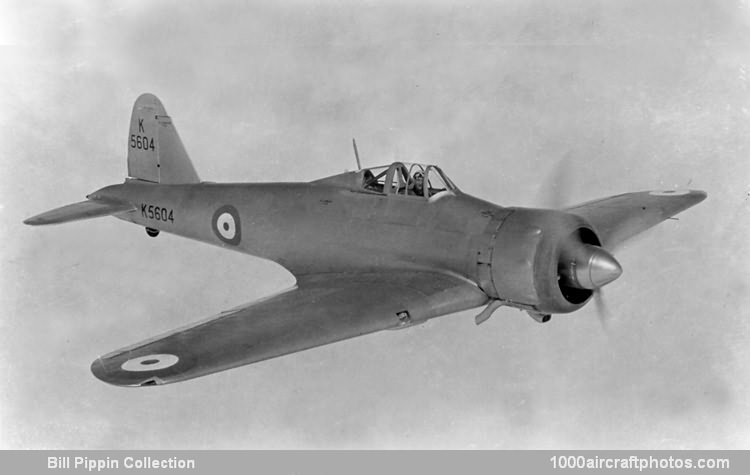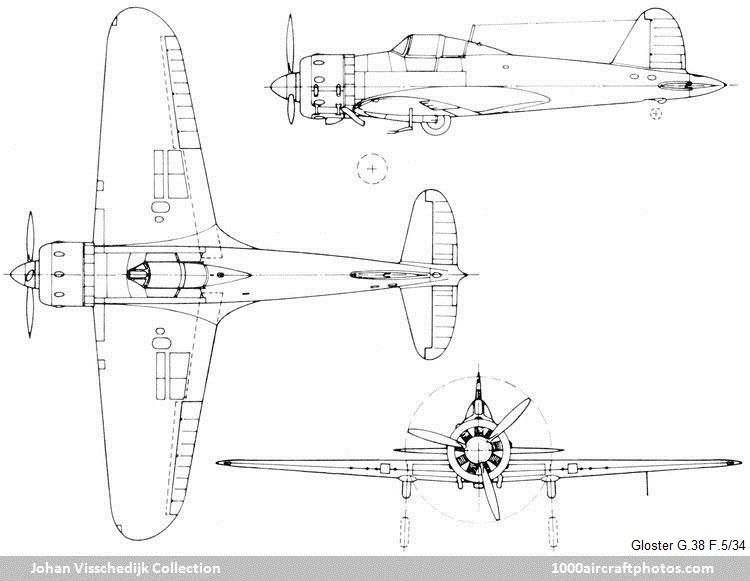Specification F.5/34 combined all the far reaching and advanced design features to step up the performance and operational efficiency of what were to be the RAF's first generation monoplane fighters, as it called for a single-seat aircraft with the heavy armament of six or eight Browning machine guns each with 300 rounds of ammunition to give a fifteen seconds duration of fire, retractable landing gear, enclosed cockpit and pilot's oxygen supply, maximum speeds of 275 mph at 15,000 ft (443 kmh at 4,572 m) and 265 mph at 20,000 ft (426 kmh at (6,096 m), a service ceiling of 33,000 ft (10,058 m) and a 90 minutes endurance.
The F.5/34's fuselage was a monocoque structure built up from light, fabricated oval-section rings with duralumin skinning. Heavier-gauge rings provided strong-point attachments for the mainplane and tail plane and for the engine bearers. The mainplane was built in one piece with the light-alloy spars running through from tip to tip and ribs made from channeling with steel and light-alloy tube struts. Duralumin stressed-skin was used on the mainplane and tail unit with fabric covered Frise ailerons, rudder and elevators. The split trailing edge flaps were all-metal and hydraulically operated. A large braced tubular-steel crash arch was housed inside the fixed portion of the cockpit canopy behind the pilot's head.
All three units of the Dowty landing gear retracted, the main wheel units swinging rearwards and upwards into the wing leaving a large segment of each wheel protruding below its lower surface. In this position they could take the full weight of the aircraft in the event of a wheels-up landing. The tail wheel retracted in a similar manner, also leaving a portion of the wheel exposed.
The armament, consisting of eight Browning 0.303 in (7.7 mm) guns with 2,600 rounds of ammunition, was mounted in the mainplanes outboard of the propeller disc; in this position the guns had an unimpeded rate of fire, eliminated the weight and complexity of synchronizing gear and took full advantage of the remotely-operated Browning's growing reliability. Large hinged panels in the upper surface of the wing provided good access to the guns for quick turnaround between sorties.
The engine was an 840 hp Bristol Mercury IX nine-cylinder geared and supercharged air-cooled radial neatly enclosed in a long-chord cowling with a leading edge exhaust collector ring and controllable cooling gills, and driving a 10 ft 6 in (3.20 m) diameter de Havilland three-blade controllable-pitch propeller. Fuel capacity was 81.66 gal (309 l), oil was 7.21 gal (27.28 l).
Mainly because of the company's involvement with the development and production of the GauntIet and Gladiator, which was absorbing all of its design office manpower, only slow progress was made with the task of building the prototype (s/n K5604), and the first flight by Gerry Sayer was not made until December 1937. A second aircraft (s/n K8089), which was similar in concept, flew for the first time in March 1938.
By that time of course, the Hurricane was in RAF squadron service and the Spitfire was in production, and, although the F.5/34 showed adequate performance and pleasant handling characteristics, Gloster failed to win a production order. Both K5604 and K8089 were transferred to Air Ministry charge and were used for experimental flying at RAE Farnborough and other Establishments until about May 1941 when they became ground instructional airframes serialed 2232M and 2231M respectively."

